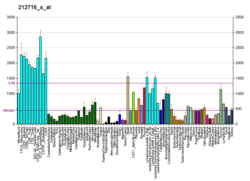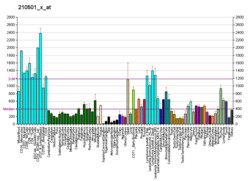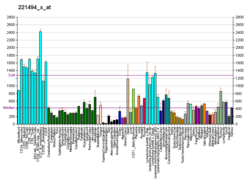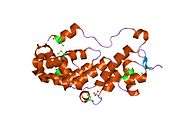EIF3K
Eukaryotic translation initiation factor 3 subunit K (eIF3k) is a protein that in humans is encoded by the EIF3K gene.[5][6][7]
Function
The ~800 kDa eukaryotic initiation factor 3 (eIF3) is the largest eIF and contains at least 12 subunits, including eIF3k/EIF2S12. eIF3 plays an essential role in translation by binding directly to the 40S ribosomal subunit and promoting formation of the 43S preinitiation complex.[8][7]
Interactions
eIF3k has been shown to interact with Cyclin D3[9] and eIF3a.[6][10]
See also
References
- 1 2 3 ENSG00000282986 GRCh38: Ensembl release 89: ENSG00000178982, ENSG00000282986 - Ensembl, May 2017
- 1 2 3 GRCm38: Ensembl release 89: ENSMUSG00000053565 - Ensembl, May 2017
- ↑ "Human PubMed Reference:".
- ↑ "Mouse PubMed Reference:".
- ↑ Zhang QH, Ye M, Wu XY, Ren SX, Zhao M, Zhao CJ, et al. (October 2000). "Cloning and functional analysis of cDNAs with open reading frames for 300 previously undefined genes expressed in CD34+ hematopoietic stem/progenitor cells". Genome Research. 10 (10): 1546–60. doi:10.1101/gr.140200. PMC 310934. PMID 11042152.
- 1 2 Mayeur GL, Fraser CS, Peiretti F, Block KL, Hershey JW (October 2003). "Characterization of eIF3k: a newly discovered subunit of mammalian translation initiation factor elF3". European Journal of Biochemistry. 270 (20): 4133–9. doi:10.1046/j.1432-1033.2003.03807.x. PMID 14519125.
- 1 2 "Entrez Gene: EIF3S12 eukaryotic translation initiation factor 3, subunit 12".
- ↑ Mayeur GL, Fraser CS, Peiretti F, Block KL, Hershey JW (2003). "Characterization of eIF3k: a newly discovered subunit of mammalian translation initiation factor elF3". European Journal of Biochemistry. 270 (20): 4133–9. doi:10.1046/j.1432-1033.2003.03807.x. PMID 14519125.
- ↑ Shen X, Yang Y, Liu W, Sun M, Jiang J, Zong H, Gu J (August 2004). "Identification of the p28 subunit of eukaryotic initiation factor 3 (eIF3k) as a new interaction partner of cyclin D3". FEBS Letters. 573 (1–3): 139–46. doi:10.1016/j.febslet.2004.07.071. PMID 15327989.
- ↑ Ewing RM, Chu P, Elisma F, Li H, Taylor P, Climie S, et al. (2007). "Large-scale mapping of human protein-protein interactions by mass spectrometry". Molecular Systems Biology. 3 (1): 89. doi:10.1038/msb4100134. PMC 1847948. PMID 17353931.
Further reading
- Karki S, Ligon LA, DeSantis J, Tokito M, Holzbaur EL (May 2002). "PLAC-24 is a cytoplasmic dynein-binding protein that is recruited to sites of cell-cell contact". Molecular Biology of the Cell. 13 (5): 1722–34. doi:10.1091/mbc.02-02-0011. PMC 111139. PMID 12006665.
- Wei Z, Zhang P, Zhou Z, Cheng Z, Wan M, Gong W (August 2004). "Crystal structure of human eIF3k, the first structure of eIF3 subunits". The Journal of Biological Chemistry. 279 (33): 34983–90. doi:10.1074/jbc.M405158200. PMID 15180986.
- Shen X, Yang Y, Liu W, Sun M, Jiang J, Zong H, Gu J (August 2004). "Identification of the p28 subunit of eukaryotic initiation factor 3(eIF3k) as a new interaction partner of cyclin D3". FEBS Letters. 573 (1–3): 139–46. doi:10.1016/j.febslet.2004.07.071. PMID 15327989.
- Olsen JV, Blagoev B, Gnad F, Macek B, Kumar C, Mortensen P, Mann M (November 2006). "Global, in vivo, and site-specific phosphorylation dynamics in signaling networks". Cell. 127 (3): 635–48. doi:10.1016/j.cell.2006.09.026. PMID 17081983.
This article is issued from
Wikipedia.
The text is licensed under Creative Commons - Attribution - Sharealike.
Additional terms may apply for the media files.







